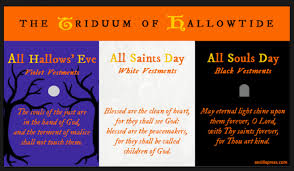Introduction
Here in Aotearoa New Zealand, many get swept up in the excitement of Halloween and the fiery celebrations of Guy Fawkes Night. Yet, nestled between the costumes, sweets and treats, bonfires, and fireworks lies an ancient trio of Christian observances known as the Hallowtide Triduum—All Hallows’ Eve (Halloween), All Saints’ Day, and All Souls’ Day. In the surge of modern festivities, the deeper spiritual meaning of these days often gets overlooked.
The Origins of Hallowtide
The term Hallowtide (or Allhallowtide) refers to the three days spanning from 31 October to 2 November in the Christian liturgical calendar. Traditionally, these days were marked by reflection on mortality, celebration of the saints, and prayers for the faithful departed.
- 31 October: All Hallows’ Eve (Halloween) – the vigil before All Saints’ Day.
- 1 November: All Saints’ Day – commemorating all known and unknown saints.
- 2 November: All Souls’ Day – dedicated to prayer for all departed souls.
From Sacred to Secular: The Shift in Focus
Halloween, once a night of prayer and fasting, has transformed into a festival of costumes, trick-or-treating, and spooky decorations. Its religious undertones—honouring the “hallowed” (holy) ones—are less recognised in mainstream culture. Meanwhile, in countries like the UK and New Zealand, Guy Fawkes Night on 5 November, with its bonfires and fireworks, commemorates a failed plot to blow up the Houses of Parliament, adding yet another layer of festivity to the season.
Between these two high-profile days, All Saints’ and All Souls’ often seem to “get lost,” their quiet solemnity overshadowed by the noise and spectacle of modern celebrations.
Remembering All Saints’ and All Souls’
All Saints’ Day is a time to honour the heroes of faith—both famous and forgotten—who have inspired generations. All Souls’ Day, by contrast, invites Christians to pray for all the departed, especially those who may have no one to remember them. These days offer a moment of pause: to reflect on the meaning of life, the inevitability of death, and the hope of life beyond.
In many communities, especially in Catholic and Anglican traditions, special church services, cemetery visits, and prayers for the dead still mark these days. In other cultures, such as Mexico’s Día de los Muertos, elaborate rituals honour ancestors with altars, offerings, and celebrations that blend indigenous and Christian practices.
Why the Triduum Matters
Reclaiming the Hallowtide Triduum can add depth to the season. It embraces the full journey from the playful encounter with death in Halloween festivities, through the recognition of sanctity in everyday life on All Saints’ Day, to acts of remembrance and compassion on All Souls’ Day.
Amidst the fireworks of Guy Fawkes and the thrills of Halloween, the festival of Hallowtide reminds us of a core human experience: community—across generations, between the living and the dead, and among the saints who inspire us all.
Conclusion
While popular culture may focus on costumes and fireworks, the days of the Hallowtide Triduum offer a richer tapestry of meaning. By remembering All Saints and All Souls, we can reconnect with traditions that honour both the joy of life and the seriousness of our mortal journey, ensuring these days are not forgotten amidst the seasonal revelry.




